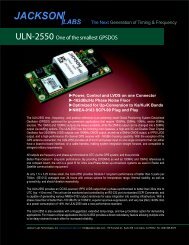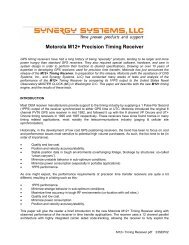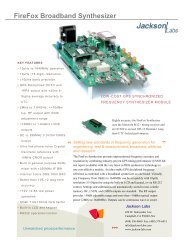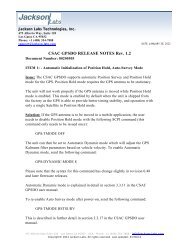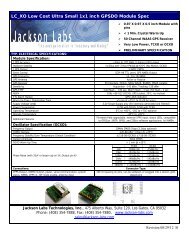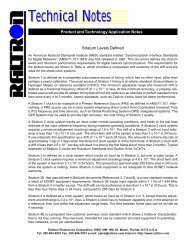FireFly-IIA User Manual - Jackson Labs Technologies, Inc.
FireFly-IIA User Manual - Jackson Labs Technologies, Inc.
FireFly-IIA User Manual - Jackson Labs Technologies, Inc.
Create successful ePaper yourself
Turn your PDF publications into a flip-book with our unique Google optimized e-Paper software.
<strong>FireFly</strong>-<strong>IIA</strong> <strong>User</strong> <strong>Manual</strong>The output of the system is in six floating point numbers: the acceleration on the X, Y, and Z axis ing’s, and the Tilt of the X, Y, and Z axis in Degrees (-90 to +90).Please note that the Accelerometer has its best resolution and accuracy when the earth’s gravitationalacceleration is perpendicular to the axis to be measured. Thus the sensors accuracy and resolutionwill be best when the tilt of any axis is around 0 Degrees. The worst performance (with an accuracyof only ~ +/-5 Degrees) is when any of the axis are at their +/- 90 Degree angles, this is due to the factthat a SIN(g-load) calculation is done to generate the output normalized to Degrees, and the vector isthus least sensitive at +/- 90 Degree angles.Acceleration can be measured with up to +/-3g range on all three axis. Please note that since the tiltangle is calculated from the acceleration vectors (using gravity) that the tilt angles will actuallyexceed +/-90 Degrees when acceleration greater than 1g is applied.3.3.12 GPS:GYRO:CALThis command calibrates the output period of the Accelerometer data (in g’s per axis, and in tilt inDegrees per axis). Both offset and gain need to be calibrated on the unit to properly format the outputof the three axis tilt to be -90 Degrees to +90 Degrees, and the 0 Degree reference.By default, the unit is shipped with a normalized output of 0 Degrees Offset, and a gain of 1.0, andthe user will need to calibrate their unit in their system.This command has the following format:GPS:GYRO:CAL , , , , , Calibration is accomplished by slowly tilting the unit on all six axis and measuring the maximum andminimum tilt indications in all six axis, and writing these down on a piece of paper to calculate thecalibration values. Later firmware releases may automate this process.Example: if the result for say the X axis is -87 Degrees to +93 Degrees, then we need to remove anoffset of +3 Degrees from the X axis while the gain of the X axis is properly set. We would thus sendthe following calibration command to the unit:GPS:GYRO:CAL -3, 0, 0, 1, 1, 1This will remove a 3 Degree offset from the X Axis, and keep the Y and Z axis without offset or gainadjustments.After the Offset is removed, we may have to adjust the gain of the axis sensor. For example if therange of the X Axis output is -82 Degrees to +78 Degrees then the axis has both an offset of 2degrees, and a gain error of 90/80 Degrees (a factor of 1.125).Thus we need to add 2 Degrees offset, and a gain of 1.125. The calibration command would thus lookas follows:14 © 2012 <strong>Jackson</strong> <strong>Labs</strong> <strong>Technologies</strong>, <strong>Inc</strong>.



